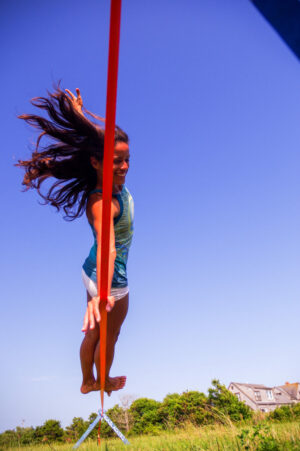Slackline Yoga
Our Practice
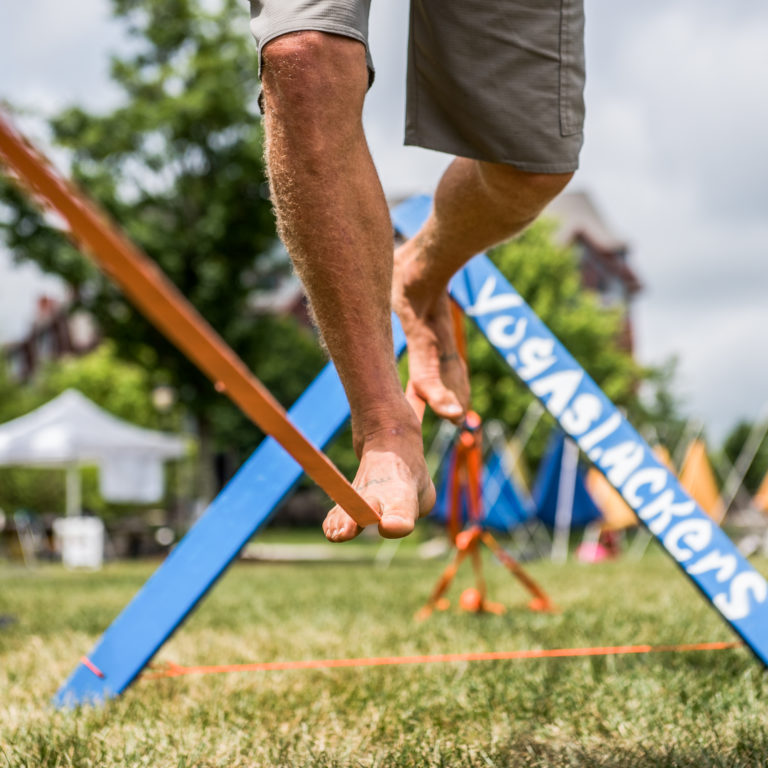
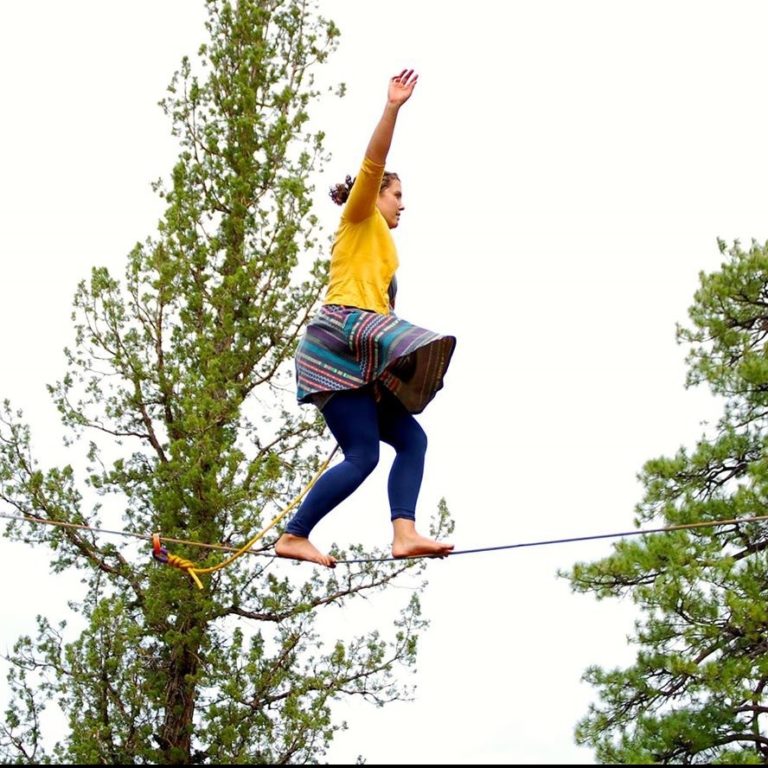
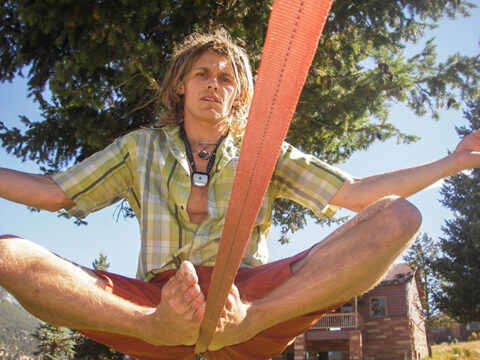
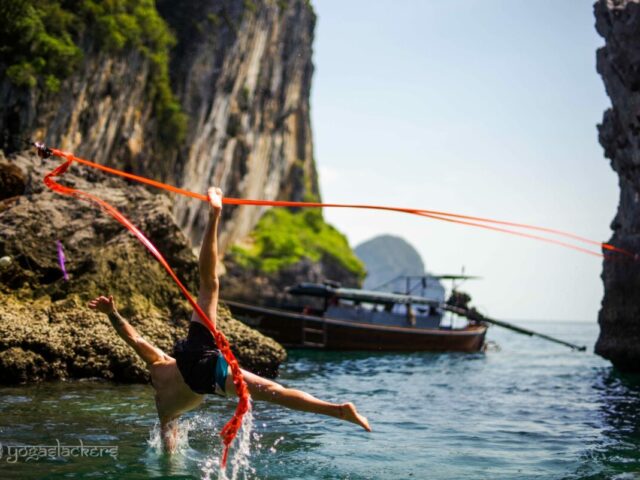
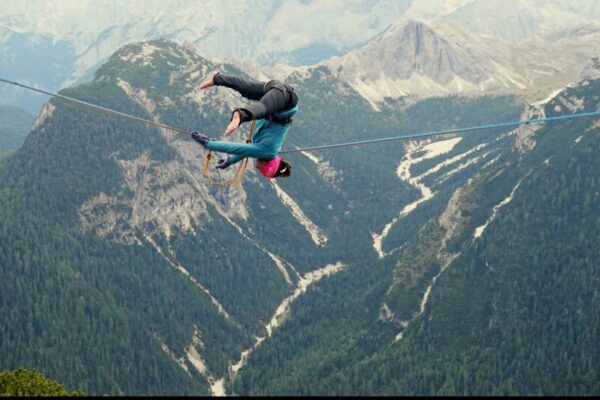
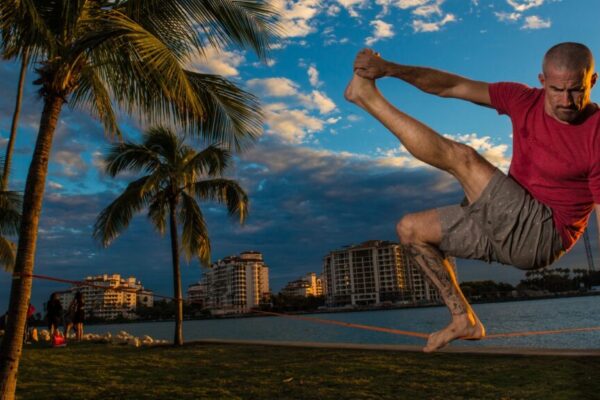
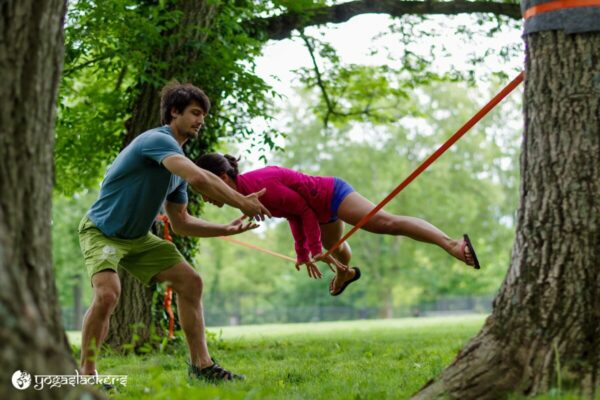
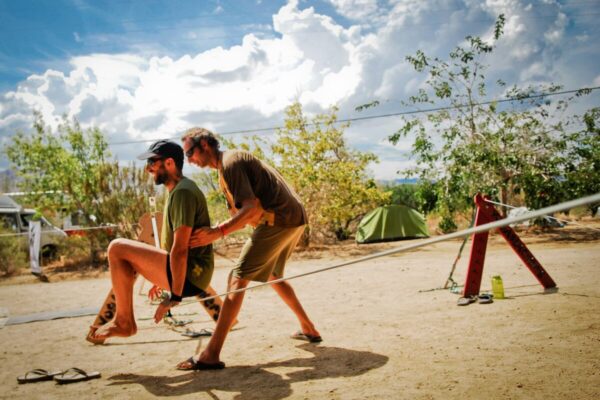
What Is Slacklining
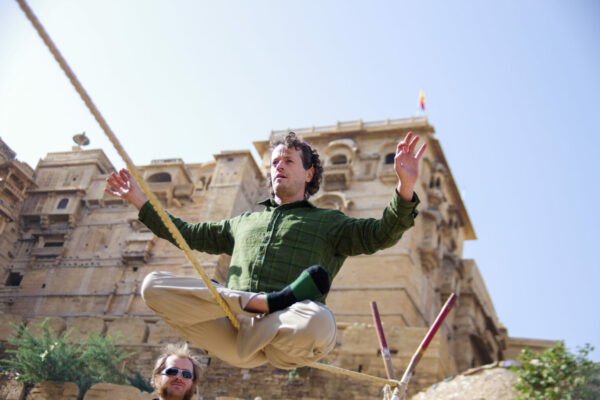
learning to slack rope in India.
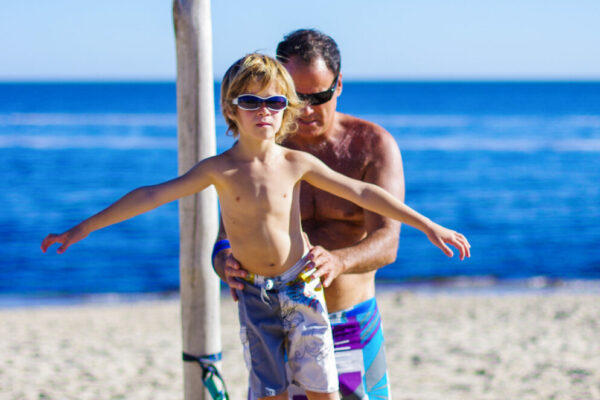
History of Slacklining
While rope walking has been around in one manner or another for thousands of years the history of slacklining is fairly recent. It all started in California’s Yosemite Valley. Where as early as the late 60’s, climbers started balancing and walking on the chains of parking lots. The birth of the slacklining as we know it can be attributed to two climbers visiting Camp 4: Adam Grosowsky and Jeff Ellington.
In the early 80’s, Grosowsky and Ellington, attempted to walk across a steel cable between the Lost Arrow Spire’s tyrolean traverse gap, next to Yosemite Falls. While the highwire walk was never completed, they did manage to create and inspire the growth of a new balancing sport: slacklining. During their practice sessions for the highwire walk, Grosowsky and Ellington rigged the first modern slacklines, no wires, no cables, no rope, instead they used 9/16th tubular climbing webbing.
Their ~25 foot long lines had tension, anchored about 5 ft off the ground with a lot of stretch, which allowed them to bounce and swing on 9/16th tubular nylon. At that length, they were still pretty high off of the ground. Surfing the line was different back then; they used the line’s bounce, extensive stretch and swing to ultimately draw an ellipse with their feet. Other tricks included Grosowsky’s amazing demonstration of a lengthy handstand on a lower, tensioned line and juggling. The two athletes passes clubs between them while standing on their own line.
The main trick at that time was to surf the line, with the goal of bouncing, unweighting, and pushing/stretching the edges of the line for as long as possible, while listening to music on a walkman. Basically drawing large ellipses with their feet. Soon after Jeff Ellington developed a special technique, the Ellington – a self locking pulley system – to tension the lines with ease. The added tension increased the walking area of the line and gave rise to modern day slacklining. (A soft release system is now known as an Ellington.)
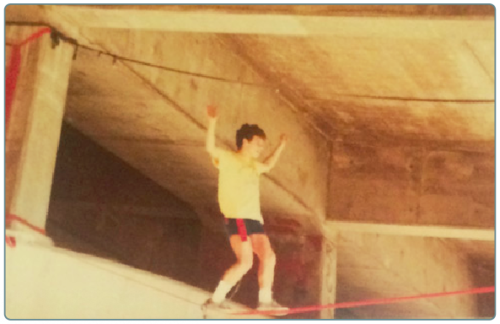
walking the first documented highline
'The Arches' in 1983.
Inspired by Adam Grosowsky and Jeff Ellington’s attempt to cross Yosemite’s Lost Arrow Spire on a highwire, Chris Carpenter and Scott Balcom rigged the first documented highline on nylon, after teaching themselves how to slackline, innovate rigging, and mentally train for about a year. In 1983 Carpenter and Balcom rigged a 2 inch-wide line under a freeway bridge near Rose Bowl in California. They fondly referred to this area as “The Arches” from their childhood explorations on that set of bridges. On a fall day in 1983, both successfully walked The Arches Highline, in both directions. They returned to The Arches over and over throughout the following months with various highline configurations in preparation for something bigger. The ultimate goal was to walk the Lost Arrow Spire on nylon webbing instead of wire. In the summer of 1984, they attempted this line for the first time. Unfortunately, at that time neither of them was able to cross that more exposed line.
The following year, 1985, Scott sent the first crossing of the now famous Lost Arrow Spire highline. His trick? He created depth perception and visual reference points below his feet by draping a climbing rope below the surface of the line with a daypack attached in the middle. This allowed him to maintain visual focus. Or as we yogis like to call it: Drishti.
For decades the sport continued to exist on a small scale as a hobby, thanks to Yosemite’s iconic dirtbag, Chuck “Chango” Tucker, who told stories about Chris and Scott’s early slackline adventures that he’d witnessed, first hand. One superstar, among a group of talented climbers in Yosemite’s Camp 4, who truly felt a calling after hearing these stories was the ultra talented alpinist, Dean Potter. It wasn’t until the early 2000s that the sport started to spread thanks to Potter’s high profile abilities as a climber, slackliner, and base-jumper. Potter’s media presence and daredevil missions placed the sport in the eyes of people across the world. The sport grew considerably in the years to follow, but it had not yet inspired the masses to practice.
In 2005 – we – the YogaSlackers started teaching slackline yoga, opening up the practice to yogis and adventure enthusiasts around the US. While the practice started to spread in the US and Europe it was Andy Lewis who gave slacklining the final kick into the eyes of mainstream America. During the 2012 Super Bowl’s Halftime show, Lewis performed with Madonna, landing the first live streamed backflip in slackline history. This was the final push needed for slacklining to become widely known and practiced.
Still to this date the sport is fairly new. Records are constantly being challenged. New poses and moves are constantly being developed. Practice and teaching methods are constantly being improved. Slacklining is a sport in which people are still figuring out the limits of its expression. Isn’t this exciting? We are all practicing a sport in which any of us could discover something new. Part of the magic of slacklining is that we are all still learning and growing together.
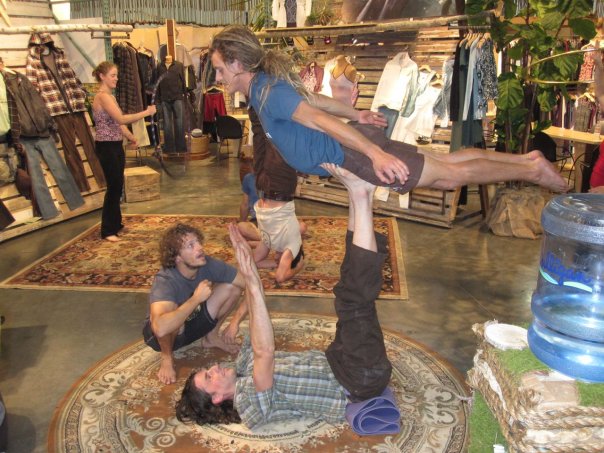
Why Slackline Yoga?
In the beginning there was Yoga. Meaning that before we became YogaSlackers or even slackliners we were yogis. Yoga is our founding principle. It is what distinguishes and informs our practice and teaching from any other style.
In its simplest definition, yoga means union and the method to attain that union. What needs to be united depends on the yogic tradition that you decide to follow. In a simplistic approach we can say that yoga means the union of the breath, body and mind. It is through this union that we can discover that we are much more than those three things and we can transcend the incorrect identification with the breath, body, or mind and connect to our Supreme Consciousness. The process of connecting to the Supreme Consciousness and realizing the ever present Self (Self Realization) is the goal of yoga.
The goal of Slackline Yoga is to achieve that said state of Self Realization through the practice of Self Regulation. Our practices focuses on putting ourselves in different asanas (postures) while balancing on a thin piece of webbing suspended over the air, in hopes to regulate our stress response and learn to connect with our calm and centered selves, regardless of the situation.
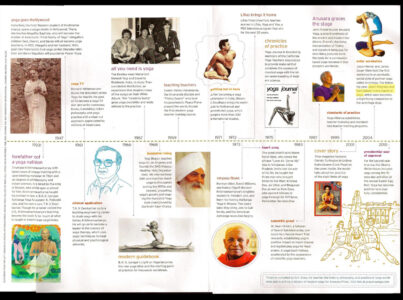
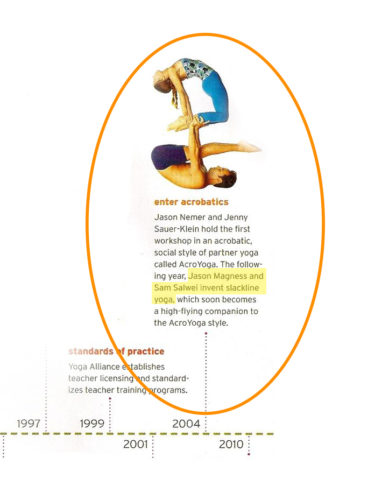
In 2015 we made it to this Yoga Journal List.
Allow your first reaction to an imbalance to be your breath. Then maybe a small movement. If that doesn’t work, freak out. Then immediately return to your breath.
Sam Salwei (co-founder of YogaSlackers)
Benefits of Slackline Yoga
- Builds muscle strength and tone
- Improves your posture
- Strengthens the core
- Improves balance
- Strengthens stabilizer muscles
- Increases breath awareness
- Improves flexibility
- Develops awareness of how to use tension as a tool
- Helps you focus
- Clears the mind
- Calms the senses
- Connects the effects of the breath with the body and mental states
- Develops discipline
- Builds confidence
- Increases an inner sense of balance
- Increases your self-esteem
- Builds awareness for transformation
- Encourages self care and care for others
- Increases your happiness
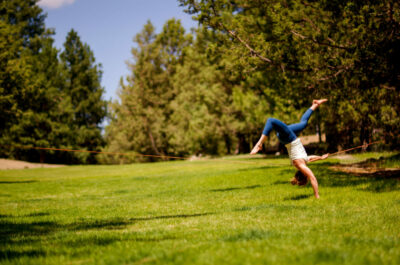
What Defines Our Practice
YogaSlackers practice is characterized by a strong focus on fundamentals, safe and thoughtful progressions and success by practice and repetition.
The main focuses of our practice are to:
(1) maintain a calm state of mind and
(2) utilize the least amount of physical effort to attain a pose.
During our classes and practices we work with our breath to calm our mind and constantly monitor both our effort and our mood. Quite often the inability to breathe smoothly or increased frustration are signs that we may need to step back a few steps onto an easier exercise. Both as teachers and practitioners, we are not afraid to return and practice foundational exercises.
The main secret to our practice is exactly that: it is a practice!
We repeat exercises over and over. We geek out on how little tension we need to hold a pose. We focus on smoother, gentler transitions and economy of movement. If something is not working out today, we do not get too attached to a move or a pose. We go back and rework our foundations until the ‘next’ pose comes to us with ease. We hope that this site we can inspire you to do the same.
